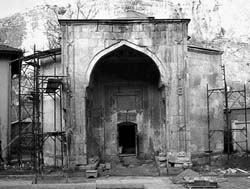Will They Open the Crimean Khans’ Tomb?

Active restoration work is being conducted in the territory of the Bakhchysarai State Historical cum Cultural Preserve. In part, approximately forty restorers are working on recreating the original look of the durbe mausoleum of the Crimean Khanate founders Khaji-Girey, Mengli-Girey, and Sakhib-Girey situated on the place of the Khanate’s initial capital, in the territory of the Zinjirly-Madrasah medieval university. According to some data, Khaji-Girey’s son, Nur-Deulet, was also buried there. In course of the restoration works, a previously immured entrance to an underground crypt was discovered in the durbe foundation. This aroused discussion as to whether it would be appropriate to enter the crypt through this entrance and research bodily remains or other objects that might be found there, which would give scholars useful information. Now heated discussions are taking place on this subject between scholars and representatives of the Crimean Muftis and the Crimean community. Will they open the Crimean khans’ tomb and, if so, what should we expect from this?
On the one hand, it seems that the opening promises many finds and discoveries: remnants of the shrouds, skeletons, or perhaps some objects of material culture. In any case, defenders of this idea speak about recreating the khans’ real appearance basing on the sculls in the tomb with the help of Academician Gerasimov’s method. Moreover, some scholars claim, basing on the suggestion that the entrance was immured in the not so far past, that perhaps Crimean Tatar scholar and public figure of the early twentieth century Useyin Bodaninsky has already explored the crypt and some works has been carried out there. However, there has been no proof found yet to corroborate this hypothesis. On the other hand, many participants of the discussion opine that opening the Crimean khans’ tomb might cause numerous disasters and cataclysms, like it was with opening Tamerlane’s tomb which some connect with the start of World War II, or researchers of the pharaohs’ tombs who died of unknown diseases or lost their minds.
What is the real stand of the Crimean archeologists? Director of the Bakhchysarai Preserve Yevhen Petrov told The Day that a meeting of Crimean scholars and public activists found opening the tomb inexpedient. The Muftis’ stand also played an important role. They insist that the religious proscription against disturbing the remains should be observed under any circumstances. Their stand is shared by leader of the scholars- restorers, research fellow Aliya Ibrahymova. In the experts’ opinion, if the scholars enter the crypt it will bring more losses than attainments. First, a historical religious tradition wouid be broken, which would leave an unpleasant moral aftertaste. Second, the tomb hardly contains any material culture objects, since by Muslim traditions the dead are buried naked, wrapped in shrouds, with no objects. Third, even if the khans’ skeletons are discovered (by preliminary estimations, there are several in the tomb), and even if their appearances are recreated with the help of Gerasimov’s method, it would be still impossible to tell who is who, since there are no reliable lifetime portraits of the Crimean governors. In addition, the task is further complicated by the fact that the scholars do not know exactly how many khans were buried in the durbe, since, according to some data, Sakhib died far from the Crimea, and the information on his funeral in the Crimea appears to be a legend. Thus, if the tomb is opened, the scholars will receive a number of skeletons whose identification is impossible. Some believe that this would be totally useless for science.
Simultaneously, in the words of Mr. Petrov, it would already be safe to say that the hypothesis that the crypt had been researched earlier, in part, by Useyin Bodaninsky, has proven unfounded. The scholars studied the immured entrance to the crypt along with the crypt’s vault and came to the conclusion that the sixteenth century’s laying is undisturbed, meaning that most probably nobody has entered the crypt after the last burial.
Is it possible that the crypt will be opened in the near future? Mr. Petrov says that there is no need for scholars to research the burial place either at present or in the future, since it will provide virtually nothing for science, while he, as a scholar, cannot base his case upon fantastic hypotheses on restoring historical figures by their skeletons. On the other hand, the restorers’ current goal is to recreate the durbe’s initial look, whose front represents considerable historical and artistic value, instead of disturbing the dead. It is planned that in the future to recreate such monuments as the durbe, Zinjirly- Madrasah itself, and local mosques (for instance, the Ismi- Khan Mosque) will make it possible to form a new exposition in the preserve that would present the Crimean Tatars history more completely.






